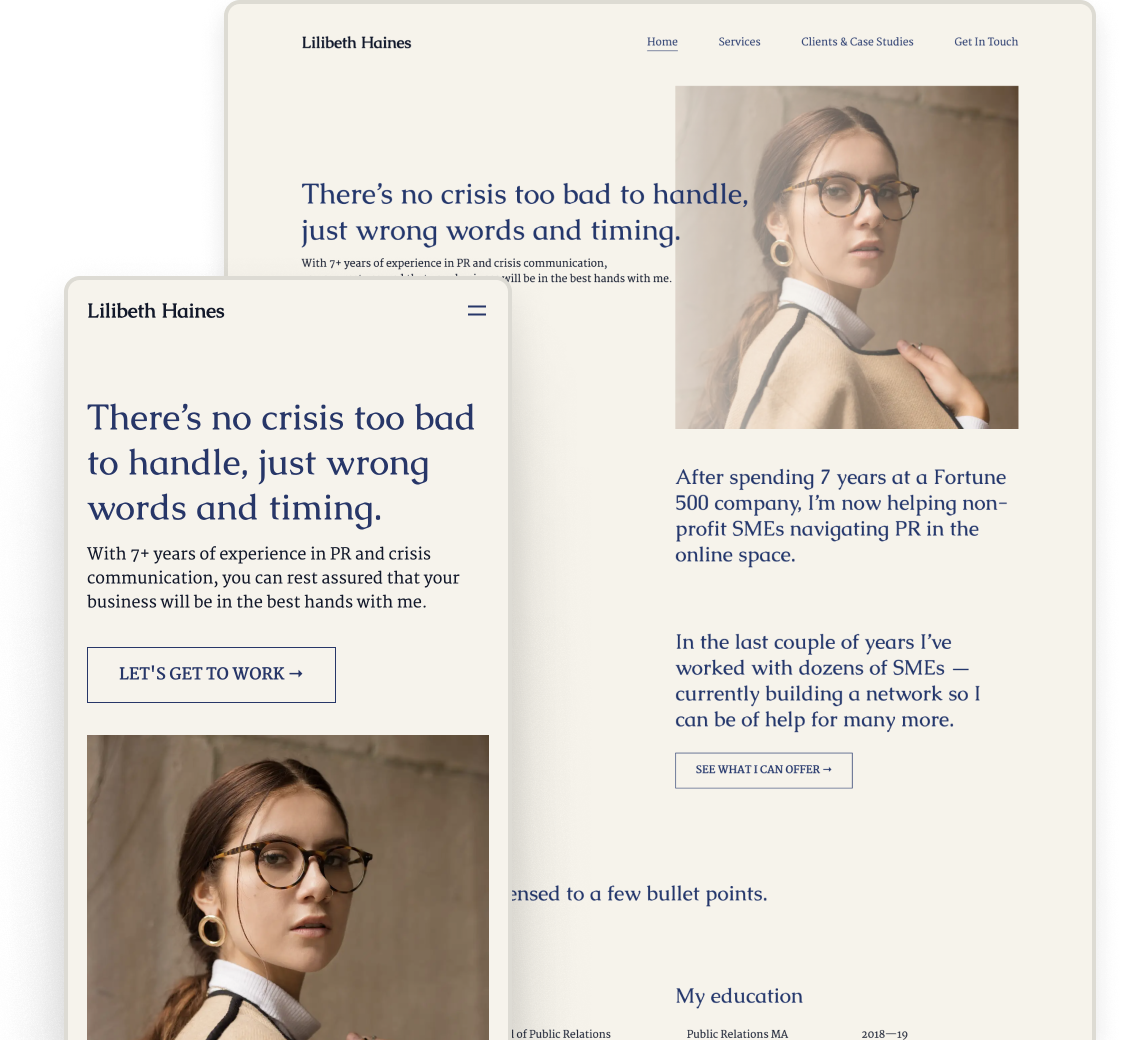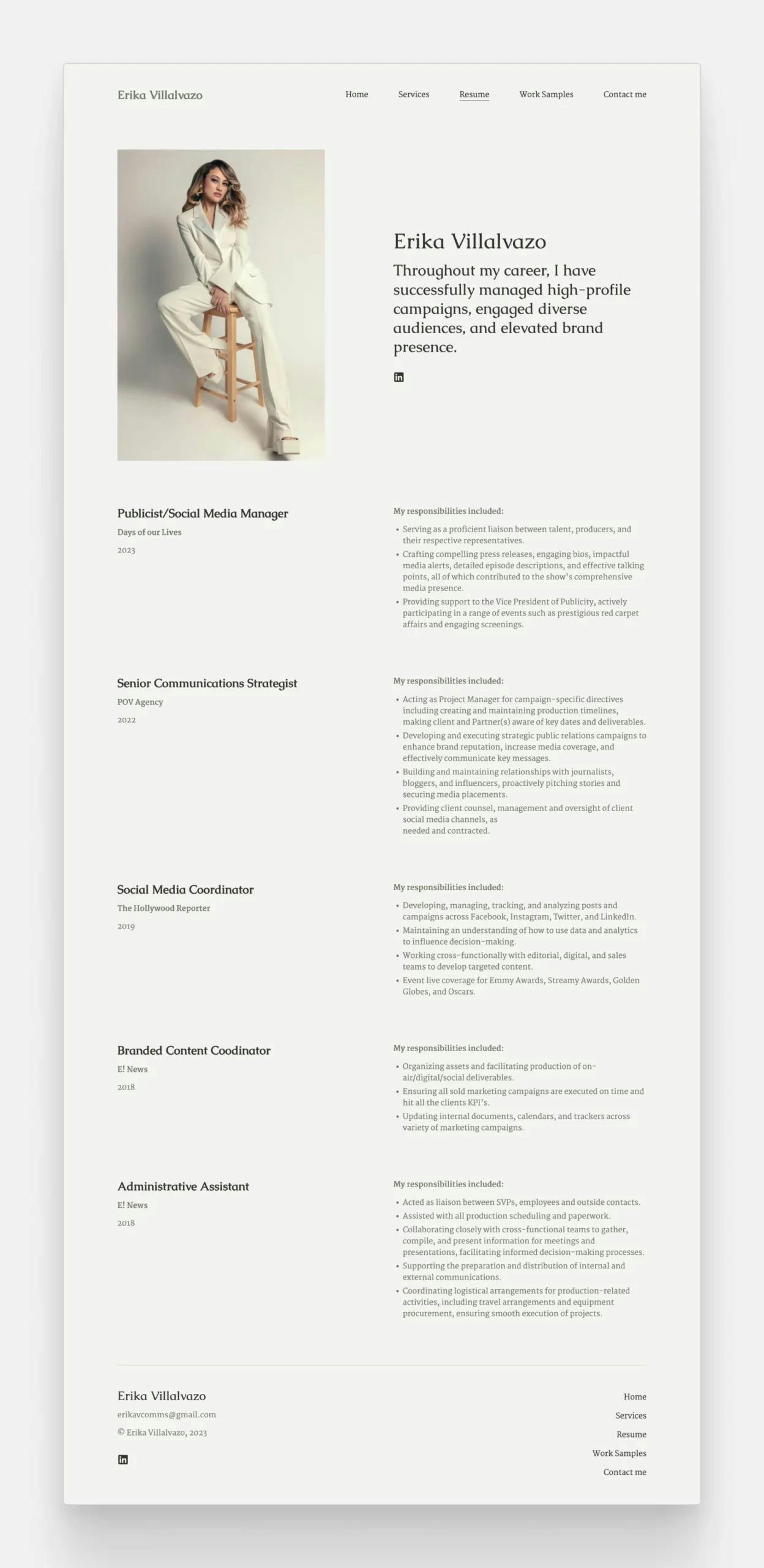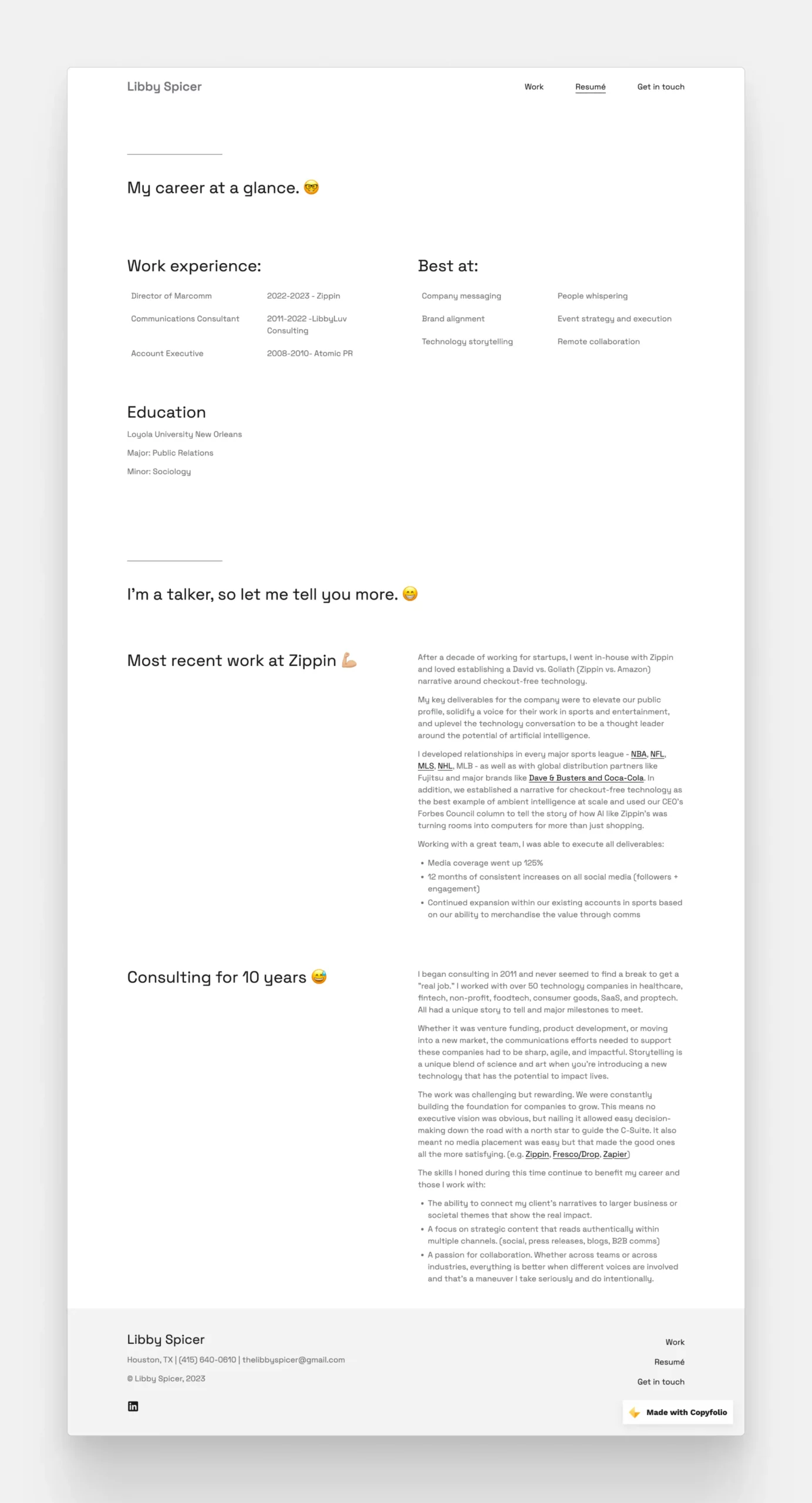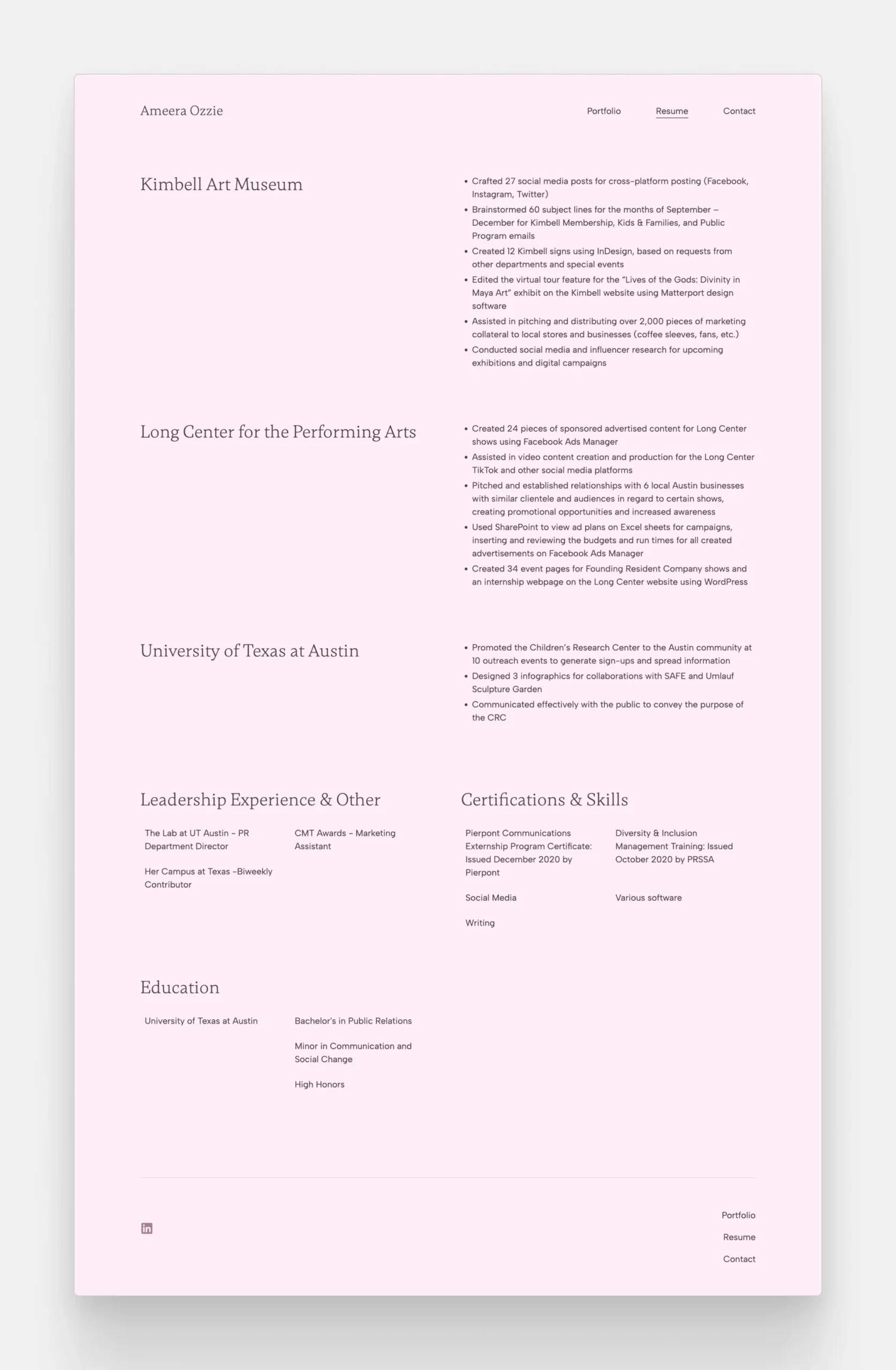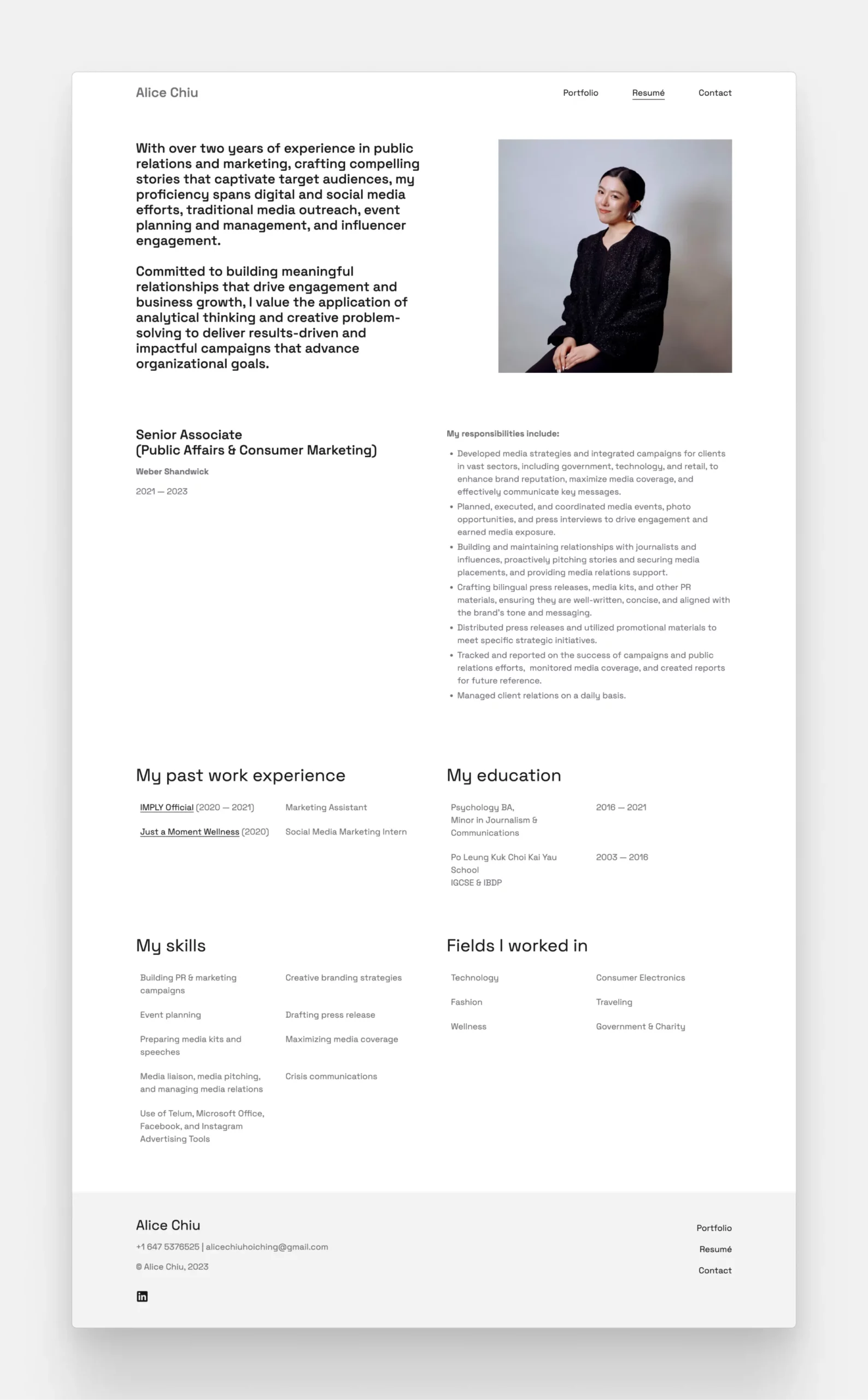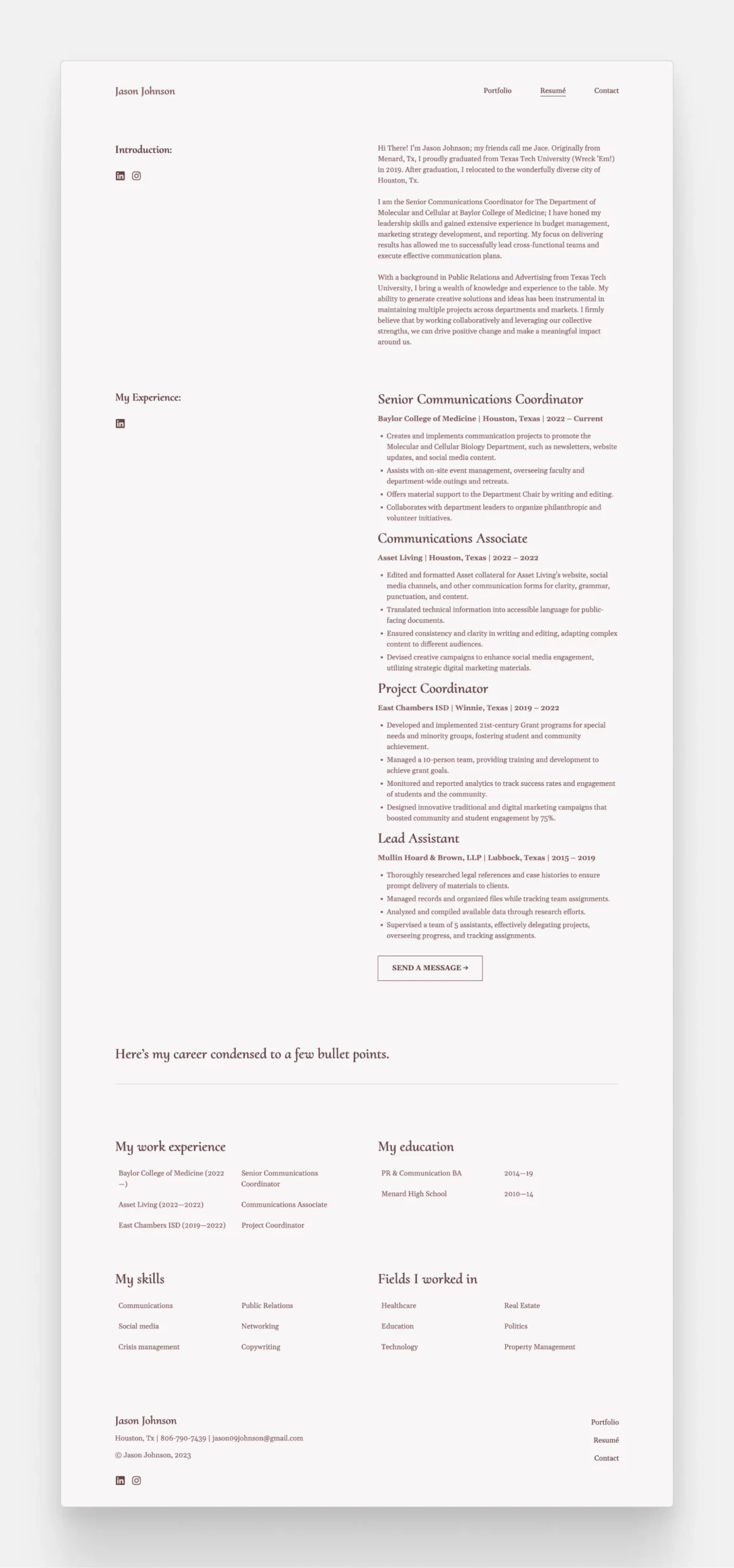6 Real-Life PR Resume Examples & How to Create Yours
The internet is full of PR resume templates written for made-up people. And while they can sometimes be good for copying a phrase or two, they’re often unrealistic and lacking personality.
So instead of flooding you with yet another article full of those fake samples, we’ll show you examples of real PR portfolios, as seen on these PR professionals’ portfolio websites.
We’ll then go over how to write a PR resume and have an interesting discussion on the best ways to create yours. One is a little unconventional but definitely worth considering if you want to be a trailblazer, standing out of the crowd.
6 PR resume examples
1. Erika Villalvazo
Erika created her resume and portfolio with Copyfolio
Erika starts her PR resume with her name, resume summary, and a picture of herself.
Contrary to most CV pictures, like BetterPic, it’s not just a simple headshot showing her face, but a full-body shot. With the quality of the picture, the stylish business attire she wears, and her serious expression, the image is undoubtedly professional. Yet it shows her professionalism and personality a thousand times better than a regular headshot would
She then dives straight into her work experience. Each position she held has the job title, company, and year on the left, and a bulleted list of her responsibilities on the right.
Erika uses excellent action words such as developing, executing, organizing, coordinating, or supporting. And even though she didn’t add a separate skills section, you get a good understanding of them as you read through her descriptions.
The only thing we’re missing from her resume are numbers. It’d be amazing to see the impact of her work: her quantified results.
2. Libby Spicer
Libby created her CV on her Copyfolio site, using resume and text sections
Libby decided to go with a no-picture resume format and wrote it all with a more casual and witty tone of voice (ToV). By doing so, she not only made her resume much easier to read, she also showcased her copywriting skills and personality.
Her CV starts by giving the reader an at-a-glance summary with the most basic information about her previous work experience, education, and skills. (The last of which she simply calls “best at”, which is one of the examples of her great ToV.)
If that got your attention, then you can keep scrolling and read the more detailed version. It’s divided for you into two section: her most recent work at Zippin (where she’s been a Director of Marketing Communications since 2022) and her 10 years of consulting experience.
We loved how for the former she’d included a bulleted list of a few of her achievements, like…
- Raising media coverage by 125%, or
- Consistently increasing the follower count and engagement rates on their social media profiles for 12 months
And for the latter, a list of the skills she’d honed during her time as a consultant.
3. Jenni Trimlett
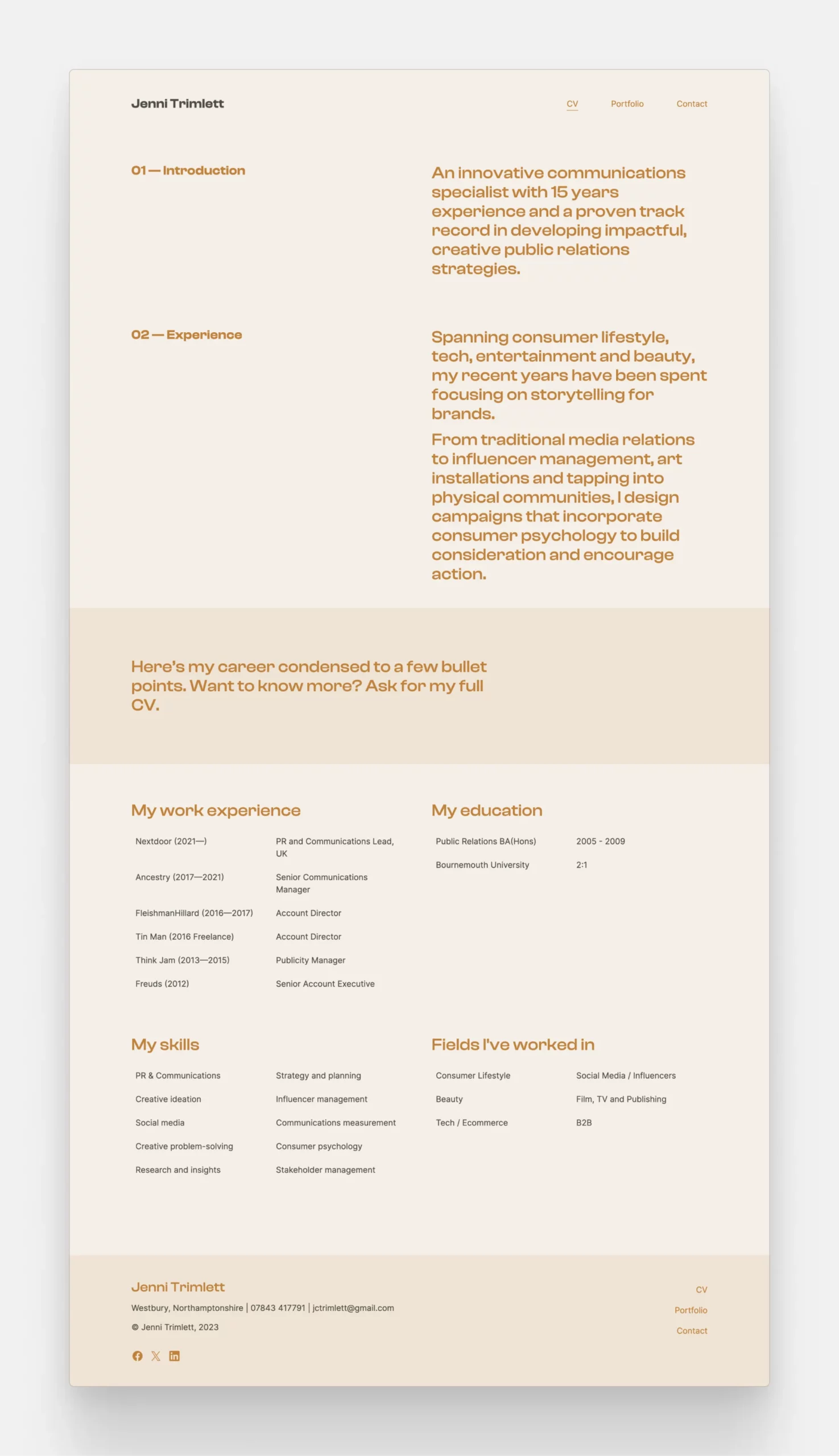
Jenni made her resume within minutes using one of Copyfolio's page presets. Like the sound of that? Create an account and give it a try yourself!
Jenni also added no picture but decided to use a more colorful color palette to make her resume visually interesting.
She starts with two big, bold, text-based sections: one titled Introduction which houses her resume summary, and another one called Experience, which highlights her areas of expertise.
Following these, Jenni dives into the traditional resume format: listing her PR work experience (e.g. being a PR and Communications Lead for Nextdoor), her education (like her Public Relations BA degree), her skills, and the fields she’s worked in.
And if you want to learn more, you can always click the LinkedIn icon at the bottom, and check out her profile for more details.
4. Ameera Ozzie
Ameera used bright colors for her resume to make it visually interesting despite having no images
Ameera’s CV is a great student PR resume example, as she’s a fresh graduate (with a Bachelor’s degree in Public Relations) looking for her first job.
She did a great job of making her resume very professional: you might not even realize her status at first glance.
Starting with the work experience, Ameera names the places she’s worked at —but without her job title or the timeframe. So even though these three were all internships lasting only a couple of months, you won’t focus on that.
Instead, you’ll focus on what she did and what skills she gained. Brilliant, isn’t it?
Once you read through that section, you’ll also find concise lists of her leadership experience, certifications, skills, and education at the bottom.
5. Alice Chiu
Alice made her PR portfolio and resume with Copyfolio
This PR resume combines multiple approaches we’ve just seen.
Alice added a professional photo to the top, alongside not just a single-sentence resume summary, but two whole paragraphs. One focuses on her areas of expertise, the other on her values and goals, almost like a resume objective.
She then wrote in detail only about her most recent experience: being a senior associate (public affairs & consumer marketing) for Weber Shandwick.
As she’s spent the last 3+ years in this position, and as it’s the most senior one she’s held, it’s going to be the most relevant for potential employers. They’ll still find her previous jobs below and can read more about them in her cover letter.
Her list of skills is also worth highlighting, as it’s full of skills relevant to PR, such as:
- Building PR campaigns
- Preparing media kits and speeches
- Crisis communication
- Maximizing media coverage
- Drafting press releases
- Media pitching and managing media relations
6. Jason Johnson
Jason's PR resume, featuring an introduction and detailing his top work experiences
Jason’s is yet another text-based resume. And while it’s a little more laid back in tone compared to some of the others, his personality still shines through. Right at the beginning you learn that his friends call him Jace and that he’s a proud alumni of Texas Tech University.
After an introduction detailing his top skills and professional interests, he continued with the traditional resume layout for work experience entries. Jason added four previous jobs to his CV, through which you can follow his career: from a lead assistant to his current position as a senior communications coordinator.
Then you’ll see the typical concise sections: short entries for work experience, education, skills, and fields he worked in.
How to write a PR resume
Hopefully, these PR resume examples gave you a little bit of inspiration. So now we can move on to the practical part of how to actually write that resume.
How long should your resume be?
First things first: how long should it be?
As short as possible when all the essential information still fits. Recruiters and hiring managers are busy people and don’t have time to read much of your resume anyway. They’ll scan for keywords they’re looking for and read the first paragraph.
If your experience is super relevant, or your writing really caught their attention, they might read on then. If not, they’ll ask you during the interview, or look to find out more either in your cover letter or your PR portfolio.
But if you’re looking for a number for a PDF resume: try to make it a one-pager. If you have a really extensive professional history, then maximum two, but no more than that.
What to include in your PR resume
Here’s a list of information you need to add to your resume:
- Your name
- Contact information
- A short summary of your expertise as a PR professional
- Your previous, relevant work experiences
- Your educational background
- Your top PR skills
And if you have any certifications widely known in the world of PR, or any special achievements and awards that could lift you above other candidates… Include those as well, of course.
Otherwise, everything else could be left for the about page of your portfolio website or your cover letter.
How to write your descriptions
As you saw, the most recent and relevant entries go beyond just a title and a date. For these previous work experiences, people like to go into more detail, to show their potential to future employers.
Here are some best practices we recommend you follow when writing these descriptions.
- Keep them short. Even though they’re important, it won’t give readers more time to spend on your resume. So edit it until they’re as concise as they can be.
- Make them easy to read. Try to imagine yourself reading it. Is it so dry you’re getting sleepy? Time for a rewrite then.
- Include numbers for achievements. There’s nothing more impactful than proof like that. Recruiters will start to imagine you bringing these numbers to their firm.
- Highlight skills you used or gained. Skills not only go in their own section. Pairing them with experiences shows the complete picture.
3 ways to create your PR resume
Knowing what to write is the first step, but you’ll then have to actually create your resume. There are three main ways to go about it, one of which you might not have even thought of before. Let’s go through them now.
Create a PDF from scratch or a template
The approach that instantly comes to mind for most people is creating a PDF.
With solid design skills and software like Adobe InDesign, you can tailor your PR resume to perfectly match your brand identity. Then export it as a PDF and attach it to your emails and applications.
And even if you don’t have said things, you could also always download or open a template, whether that’s in Microsoft Word or Canva, and fill it with your own data. Even if it won’t be 100% custom, it’ll save you loads of time. For added security while working online, consider a vpn download to protect your personal information and keep your data private during the resume creation process.
Use a resume builder software
Another option is using a resume builder. These apps were developed to make creating your CV as easy as possible, with templates and guidelines. Some even check the resume you created and give you tips on where you could improve.
Similarly to using templates from our previous point, your resume might not look very on-brand or custom, if you go this route. You could also run into a paywall quickly if you want to use more than the bare minimum features.
Add it to your website
Now here comes the unconventional part. Did you know that your resume doesn’t always have to be in the form of a PDF?
You can also host it on your website and send a link to it alongside your application. E.g. when you apply via email. It’s a great option, because:
- The look of your resume will match your personal brand and website
- With the right tool, putting it together will be faster and easier
- Recruiters reading your resume can easily check your portfolio too, increasing your chances of getting hired
- People can find it by themselves (via SEO or social shares), giving you more work opportunities
- It’s always going to be up-to-date, no need to worry about having to make adjustments after sending it off
The biggest disadvantage of this method is that you can’t tailor your resume to each application separately. But if you’re applying for positions relevant to your skills and experience, it shouldn’t be a problem. Especially if you write a convincing cover letter to go with it.
No website yet? Here’s how to create one easily
If you like the sound of this approach and the examples we’ve shown earlier but have no website yet… Don’t worry. We’ll show you how to create a professional PR portfolio website in a matter of minutes.
- Choose a website builder that makes it easy, like Copyfolio, and create an account.
- Select your profession and the goals of your site (adding your portfolio, showcasing your services, or writing a blog), so that Copyfolio can generate the content of your starter site based on that
- Pick a template that you like: it’ll determine how the top section of your homepage, your buttons, title sections, and footer will look like. You can change the fonts and colors (or the template itself) anytime.
- Rewrite the tagline and upload your photo. It’s incredibly important that people know who you are and what you do, right when they land on your website.
- Adjust the content, so it’s about you. Copyfolio will add sections and fill them with content fitting your profession, but you’ll need to add your personal touch here and there, to make it truly yours.
- Get your own domain or customize your Copyfolio URL. To look professional and be able to share your site easily with the world, it’s best to have an easy-to-remember link.
All the other steps depend on what you want to do with your website. If it’s just your online profile, then perfect the copy and work on your about page. If you use it as a portfolio, then add all your top projects. If you’re going to blog, then add a blog section and start writing!
Want to see all the features Copyfolio has? See them in action in this video!
